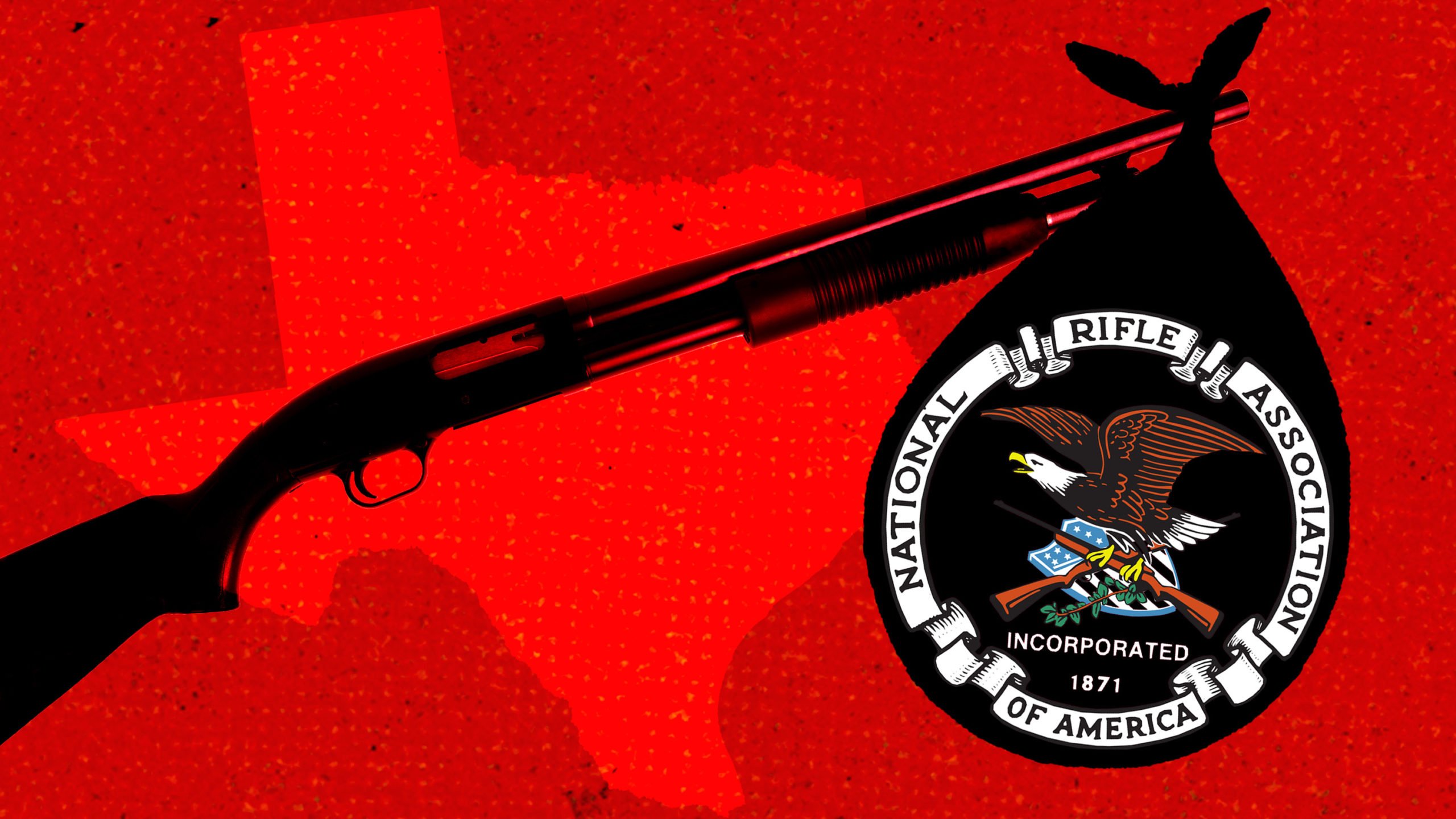On January 7, the National Rifle Association’s board of directors gathered at the Omni Hotel in downtown Dallas for the group’s winter meeting. Despite the risks of travel during a pandemic, half of the board’s 76 members had made the trip. After breakfast, the directors turned off their cell phones and handed them over to security staff to be put in signal-blocking bags, then took their seats under modernist circular chandeliers in the hotel’s largest ballroom.
The meeting was brief.
Directors established a Special Litigation Committee to oversee sensitive legal matters and approved a revised employment agreement for embattled NRA chief executive Wayne LaPierre. A clause authorized him to “reorganize or restructure the affairs of the association.”
Eight days later, the NRA filed for bankruptcy in Texas and announced a plan to make the state its new home. No mention of the move appears in minutes of the winter meeting. “I was aghast when I found out,” said board member Phillip Journey, who attended. “I was dumbfounded.”
NRA outside counsel William A. Brewer III helped execute the plan, which his firm was developing in the summer and fall of last year. In July 2020, Brewer’s firm prepared a slide presentation on how the NRA could escape New York — and an investigation by the state’s attorney general, Letitia James. The presentation, marked “Privileged & Highly Confidential,” stressed that, in order to slip free from James’s grasp, the NRA needed a friendlier state to amend its laws and provide an exit ramp.
The presentation, along with other internal documents reviewed by The Trace and interviews with attorneys familiar with Brewer’s maneuvers, show a haphazard effort to find a way out of New York. They also raise questions about whether Brewer is protecting LaPierre at the expense of the organization that he has led for 30 years.
While the NRA remains the country’s most powerful gun rights group, it has been badly weakened by scandal. The bankruptcy is further consuming the organization just as mass shootings in Atlanta and Boulder, Colorado, have refocused attention on gun regulation. In the 90 days before the bankruptcy filing, the NRA paid the Brewer firm $17.5 million, according to disclosures made in the case — more than it spent on the 2020 presidential race.
The bankruptcy move has puzzled experts, not least because the NRA claims it has plenty of cash and is motivated, in the words of LaPierre, by a desire to be “free from the toxic political environment of New York.” That’s not a basis for bankruptcy, experts have said, and exactly how it leads to a Texas-based NRA is not obvious. At most, they said, the bankruptcy filing may prolong the clash with James and perhaps offer some superficial leverage.
In a recent bankruptcy filing, the group said it was working with Texas Governor Greg Abbott’s office “to facilitate its reorganization.” Under questioning by creditors in the case on February 22, LaPierre said, “Texas made it clear that they really wanted us… They have an enterprise fund that would help and they are organized in a way to really bring in business.”
The NRA is a New York corporation with headquarters in Virginia and was able to file for bankruptcy in Texas only because it had quietly formed an affiliate, Sea Girt LLC, in the state 52 days before. When the bankruptcy was filed in Dallas, Sea Girt told the court it had $50,000 in assets. Two days before, LaPierre had ordered the money transferred from a trust account established to pay the Brewer firm, which has offices in Dallas and New York City.
NRA officials have testified in the bankruptcy case that board members were not told of Sea Girt’s creation. LaPierre said that he and the Special Litigation Committee, composed of three NRA executives with a history of backing LaPierre, made the decision. “The NRA has been looking to move for some time,” he testified. “We should have done it a decade ago.”
Neither the Brewer firm, the NRA, nor LaPierre’s personal attorney responded to calls and written questions for this story.
In a July 2019 tweet, then-President Donald Trump lashed out at James for “harassment” of the NRA and predicted that the group would “move quickly to Texas,” where it is “loved.” An NRA spokesperson thanked Trump for his support, but said the NRA intended to stay in New York.
A year later, Brewer attorneys were grappling with relocation in the slide presentation, though it’s unclear whether the slides were shown directly to the NRA.
Attorneys laid out three ways to relocate: Dissolution, which would involve moving NRA assets to an entity in another state and ceasing existence in New York; a merger with an entity in another state; or conversion, which is typically only permitted with approval from an entity’s state of origin.
The lawyers concluded that the NRA was boxed in, largely because the New York attorney general has authority over dissolution of nonprofits and distribution of nonprofit assets. The presentation quotes state law on conversion in Alaska and in Texas, which bars the move “when prohibited by or inconsistent with the laws of the converted entity’s jurisdiction of formation.”
The final slide is a “wish list” of three specific, technical actions an NRA-friendly state could take to help.

Before any such move could be made, James filed a lawsuit seeking the NRA’s dissolution. She alleged that LaPierre and other executives had looted the nonprofit and that their various schemes had cost the NRA more than $63 million in the last three years alone. James was also critical of the NRA’s relationship with Brewer and his firm, alleging that the group had been reckless in expanding the firm’s mandate and in the legal fees it had paid. The NRA reacted with its typical belligerence. “We’re ready for the fight,” LaPierre said. “Bring it on.”
It’s easy to see why the NRA chose to seek refuge in Texas, where the group claims more than 400,000 of its 5 million members reside. NRA board member Allen West chairs the Texas GOP. West has supported a statewide referendum, sometimes labeled “Texit,” to secede from the United States and adopted “We are the Storm,” a phrase associated with the Q-Anon conspiracy, as his party’s slogan. Top officials, Republicans all, share the NRA’s enthusiasm for Trump. In New York, Democrats hold power, and law enforcement agencies, including James’s office, have pursued several investigations of the former president and his businesses.
Governor Abbott, who signed all 10 of the NRA-backed bills the Texas Legislature sent him during its session in 2019, said in January that he wants the state to become a “Second Amendment sanctuary” so that “no government official at any level can come and take your gun away.” After James filed her lawsuit and Trump again encouraged a move to Texas, Attorney General Ken Paxton tweeted, “The NRA has been instrumental in defending our Second Amendment rights and we would welcome them with open arms to relocate in Texas!”
In Texas, as in New York, the attorney general oversees nonprofits. Unlike in New York, the Texas Attorney General’s Office lacks the resources to comprehensively enforce state nonprofit law, according to Darren Moore, a Fort Worth attorney who specializes in nonprofits. “It can be kind of like the Wild West,” Moore said. “Unfortunately, there is not always a lot of accountability.”
Paxton himself has been under indictment on securities fraud charges since 2015. Legal challenges have bounced the case from one court to another, and it’s unclear whether he will ever be tried. The FBI is reportedly investigating Paxton after seven senior attorneys in his office went public last year with concerns that he had taken bribes and abused his position.
In December, Paxton filed a widely ridiculed lawsuit challenging presidential election results in four states where Joe Biden had prevailed, but the U.S. Supreme Court declined to hear it. Paxton is a member and former chairman of the Republican Attorneys General Association, whose subsidiary, the Rule of Law Defense Fund, was behind a robocall that urged participation in the January 6 protests that led to deadly violence in Washington, D.C. “We are hoping patriots like you will join us to continue to fight to protect the integrity of our elections,” the recording said. Paxton also spoke at the Trump rally that preceded the violence.
Two weeks before, 16 GOP attorneys general — including Paxton — filed a brief supporting the NRA in a federal suit that Brewer brought against James. A New York attorney with ties to the GOP machine on Long Island, Steven Losquadro, represented the group. Brewer and Losquadro have been involved in prior cases and both represented rapper 50 Cent in his 2015 bankruptcy, which he filed just as the punitive damages phase of his trial for releasing a sex tape meant to embarrass a rival musician was to start. A Justice Department monitor objected to expenses Brewer sought payment for in the case, asserting that hotel rooms costing more than $500 a night and $2,300 in minibar charges could not be justified. Brewer was 50 Cent’s counsel in the case and Patrick Neligan, another Dallas attorney, was the musician’s bankruptcy lawyer. The two attorneys have the same roles in the NRA bankruptcy.
In early June 2020, according to an individual familiar with the matter, lawyers at Brewer’s firm met with an attorney from the Republican Attorneys General Association to enlist its help against James. The NRA has given more than $1.3 million to the association since 2014 and also has a “business services” contract with the group, according to bankruptcy disclosures. They show that the NRA paid the association $10,000 the day before the bankruptcy filing.
Matthew Lacombe, an assistant professor of political science at Barnard College and author of “Firepower: How the NRA Turned Gun Owners into a Political Force,” said relocation to Texas marks a logical next step in the group’s trajectory. In the late 70s, Lacombe said, the NRA was divided between an old guard that wanted to maintain a measure of political neutrality and backed building a new headquarters in the West, and a hardline bloc allied to the emerging New Right. At the NRA’s annual meeting in 1977, the old guard was toppled and the group’s evolution into a giant of conservative politics was underway. The NRA adopted a political identity and message that presaged Trump’s own, Lacombe said. Through its alliance with the ex-president, he said, the NRA became further tied to a rising, conspiracy-minded wing of the GOP. “You could imagine the NRA pulling back from the Trump wing of the Republican Party,” he said, “but if this move goes through, it would suggest they are not altering course.”
On the day that James filed her dissolution suit, Brewer countersued in federal court, charging that the attorney general was waging a political vendetta. In the weeks after, attorneys at Brewer’s firm drafted arguments to get James’ case dismissed and began to mull bankruptcy. A memo written in September by an attorney for the firm determined that bankruptcy was unlikely to shield the organization from James, according to a lawyer who read the document.
When lawyers looked for a basis to dismiss the case, they concluded that James had not met the legal standard necessary to seek the NRA’s dissolution. Typically the attorney general pursues nonprofit executives for wrongdoing and treats the organizations they lead as victims of crooked leadership. No instance was found of the Attorney General’s Office, under James or any predecessor, ever having tried to dissolve a nonprofit because of the illegal conduct of its executives. James’s most serious accusations center on misuse of NRA funds by executives, and draft arguments reviewed by The Trace highlight the lack of any assertion in her lawsuit that the NRA board knew about — let alone approved — the financial transactions.
Some of the arguments showed up in an amended complaint that Brewer filed in October in the NRA’s federal lawsuit against James. But they were not included in any motion to dismiss that the NRA filed. The dismissal motions were procedural — and were rejected. If protecting the NRA had been Brewer’s priority, logically, the substantive arguments would have been deployed even if they posed a risk to LaPierre, according to an attorney who has worked on NRA matters. “Making these types of arguments would have been in the NRA’s interests,” said the attorney, who asked not to be named for fear of retaliation, “and he did not do that. What he did was what would be more in Wayne’s interest.”
By many accounts, LaPierre has ceded considerable authority to Brewer. The Trace has detailed concerns that Brewer has prioritized the interests of LaPierre, who approves his invoices, over the NRA itself. According to sworn court statements, LaPierre, who is reportedly under investigation for tax fraud, has repeatedly said that only Brewer can keep him out of jail.
Brewer “will literally say, ‘Are there any other motions I can file?’” said the attorney who has worked on NRA matters. “He’s just looking for shit to slow things down.”
The bankruptcy filing follows several failed attempts by Brewer to get James’s case halted and rerouted to federal court. Brewer feels that state court judges in New York are politically biased in favor of Democrats, according to the attorney, who has spoken with him on the topic.
Ackerman McQueen, a public relations firm that worked closely with the NRA for decades before their relationship collapsed in 2018, has joined James in asking that the bankruptcy be dismissed as a bad-faith filing. They allege that Sea Girt is a shell entity created to secure a favorable forum, and point to public statements by LaPierre and the NRA stressing the group’s financial health and describing the bankruptcy as a way to evade a reckoning with James.
Anthony Casey, a bankruptcy expert at The University of Chicago Law School, said the evidence strongly supports dismissing the NRA’s bankruptcy for bad faith. However, judges have substantial latitude on these matters. If the NRA persuades the court that its legal entanglements are a threat to its solvency, the case could proceed. “It’s not that you need to have an absence of bad faith,” Casey said. “You need evidence of some good faith.”
In filings and hearings in the case, NRA attorneys have stressed that, despite public statements by LaPierre and other leaders, the organization is not using bankruptcy to evade a legal showdown with James, and will continue to defend itself in New York. But they’ve also said the bankruptcy reorganization plan — which it has yet to give the court — will provide for full payment to its creditors and offer “a mechanism for adjudicating and/or resolving“ the James suit. Casey said bankruptcy allows for no such mechanism: “You can’t file for bankruptcy just because you would prefer to have a bankruptcy court decide a matter of New York law.”
Several days of hearings on whether the bankruptcy should be dismissed are scheduled to begin on April 5. Even if the case goes forward, Brewer may be thrown off. A Justice Department office that acts as a watchdog in bankruptcies has filed a motion objecting to Brewer serving as the NRA’s outside counsel, in part because the NRA may have future claims against Brewer for “fraudulent conveyance based on allegations of billing improprieties.”
The monitor also contends that the Brewer firm is compromised by its past representation of LaPierre, who has driven out NRA officials who tried to scrutinize Brewer’s billing.
In the days before the NRA filed for bankruptcy, there was a furious push inside the Brewer firm to get invoices paid, according to an attorney involved and communications reviewed by The Trace. On January 14, LaPierre approved payments to the Brewer firm, which collected a total of $2.4 million from the NRA that day, according to bankruptcy disclosures.
The day before, LaPierre’s personal attorney, P. Kent Correll, had sent the NRA an $80,400 bill for work that he’d done since January 1. LaPierre retained Correll in September as concerns that the Brewer firm could not represent both the NRA and LaPierre intensified. (Like Neligan, the bankruptcy lawyer who worked with Brewer on 50 Cent’s case, Correll has history with the NRA counsel. Brewer once employed Correll, and both attorneys have worked for a development group behind a proposed ice-skating complex in the Bronx.)
Correll billed for work specific to LaPierre, but also for “strategy discussions” with Brewer. A portion of the invoice for January 5 — two days before the board met at the Omni Hotel — states “prepare for meeting in Dallas re: litigation strategy,” and notes discussions with Brewer and LaPierre. Correll also billed for work on LaPierre’s employment agreement, the one that would give him authority to “restructure and reorganize the affairs of the association.”
An attorney who has observed the working relationship between Correll and Brewer said they coordinate closely. That in itself is not a problem, but lawyers in such situations are supposed to be guided by the individual interests of their respective clients. The attorney saw no evidence of that, saying: “I don’t see any independence between NRA counsel and Wayne’s counsel. They act as if it’s one law firm representing one party.”
In other words, LaPierre’s personal interests are in part driving the NRA’s legal strategy — at a moment when gun-rights enthusiasts are meeting stiffer political winds and the group faces unprecedented danger.
Daniel Nass contributed to this report.


